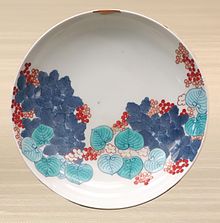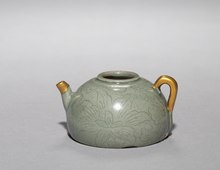Kintsugi
[3] One theory is that kintsugi may have originated when Japanese shōgun Ashikaga Yoshimasa sent a damaged Chinese tea bowl back to China for repairs in the late 15th century.
[2] On the other hand, according to Bakōhan Saōki (record of tea-bowl with a 'large-locust' clamp), such "ugliness" was considered inspirational and Zen-like, as it connoted beauty in broken things.
[13] Kintsugi can relate to the Japanese philosophy of mushin (無心, "no mind"), which encompasses the concepts of non-attachment, acceptance of change, and fate as aspects of human life.
Alternatively, thick cardboard boxes are sometimes used as the furo as they create a steady atmosphere of humidity or large vessels filled with rice, beans, or sand into which the mended pottery is submerged.
[12][16] Kintsugi is the general concept of highlighting or emphasizing imperfections, visualizing mends and seams as an additive or an area to celebrate or focus on, rather than absence or missing pieces.
Modern artists and designers experiment with the ancient technique as a means of analyzing the idea of loss, synthesis, and improvement through destruction and repair or rebirth.



